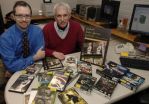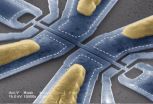(Press-News.org) AMES, Iowa -- As president of the International Society for Research on Aggression (IRSA) and with consent of the organization's elected council, Craig Anderson appointed an international Media Violence Commission last December to prepare a public statement on the known effects of media violence exposure, based on the current state of scientific knowledge. The Iowa State University Distinguished Professor of psychology appointed 12 IRSA researchers to the commission, including Douglas Gentile, an ISU associate professor of psychology.
The Media Violence Commission's research-based report concludes that the research clearly shows that media violence consumption increases the relative risk of aggression, defined as intentional harm to another person that could be verbal, relational, or physical. The report is published in the September/October issue of the journal Aggressive Behavior (http://onlinelibrary.wiley.com/doi/10.1002/ab.21443/full).
"Basically, the commission looked at, 'What does the research literature say?'" Anderson said. "In addition, we asked them to make some recommendations, if they chose to do so, about public policy. It really was kind of an open-ended charge."
A well-known researcher on the effects of media on children, Gentile says commission members took a fair and balanced look at all of the existing research to see if they could achieve consensus, and then summarized what they found.
In their report, the commission wrote that aside from being sources of imitation, violent images -- such as scenes in movies, games or pictures in comic books -- act as triggers for activating aggressive thoughts and feelings already stored in memory. If these aggressive thoughts and feelings are activated over and over again because of repeated exposure to media violence, they become chronically accessible, and thus more likely to influence behavior.
"One may also become more vigilant for hostility and aggression in the world, and therefore, begin to feel some ambiguous actions by others (such as being bumped in a crowded room) are deliberate acts of provocation," the commission wrote in the report.
The commission recommends that parents know what media their children and adolescents are using. Rating systems often provide too little detail about media content to be helpful, and in any case, are not substitutes for parents' watching, playing, or listening to the media their children use.
"Parents can also set limits on screen use (The American Academy of Pediatrics recommends no screen time for children under 2 and no more than one to two hours total screen time per day for children/youth 3-18), and should discuss media content with their children to promote critical thinking when viewing," the researchers wrote. "Schools may help parents by teaching students from an early age to be critical consumers of the media and that, just like food, the 'you are what you eat' principle applies to healthy media consumption."
While most public policy has focused on restricting children's access to violent media, the commission found that approach to have significant political and legal challenges in many countries. For that reason, it recommends putting efforts into improving media ratings, classifications, and public education about the effects of media on children.
"Improving media ratings really has two pieces. One is that the media ratings themselves need to be done by an independent entity -- meaning, not by an industry-influenced or controlled system," said Anderson, himself a leading researcher of the effects of violent media on children. "They need to be ratings that have some scientific validity to them.
"But the other piece is education, and if parents aren't educated -- not just about what the ratings system does, but also about why it's important for them to take control of their child's media diet -- then it doesn't matter how good the ratings system is, because they're going to ignore it anyway," he added.
Anderson hopes the final report will have value to child advocacy groups.
"Having such a clear statement by an unbiased, international scientific group should be very helpful to a number of child advocacy groups -- such as parenting groups -- in their efforts to improve the lives of children," he said.
INFORMATION:
Special international commission on media violence confirms aggression link
Commission recommends that parents know what media their children and adolescents are using
2012-08-27
ELSE PRESS RELEASES FROM THIS DATE:
CancerMedsCanada.com Partners with Great Canadian Pharmacy to Provide Cost-Effective Prescription Drugs Online
2012-08-27
CancerMeds Canada is an affiliate for a well-known leading global pharmacy intermediary GreatCanadianPharmacy.com. "Since 2004, our goal at GreatCanadianPharmacy.com is to provide consumers affordable Canada drugs through our unique network of licensed global pharmacies and Canadian pharmacies," explains the owner of CancerMedsCanada.com, Thomas Unger. "We aim to be one of the forerunners of premier prescription fulfillment service providers on the Web."
GreatCanadianPharmacy.com offers the cheapest and best drug prices for its consumers on the Web. ...
Mayo, UCSF team discovers genomic variant that increases risk of brain tumors
2012-08-27
ROCHESTER, Minn. -- People who carry a "G" instead of an "A" at a specific spot in their genetic code have roughly a six-fold higher risk of developing certain types of brain tumors, a Mayo Clinic and University of California, San Francisco study has found. The findings, published online today in the journal Nature Genetics, could help researchers identify people at risk of developing certain subtypes of gliomas which account for about 20 percent of new brain cancers diagnosed annually in the U.S. and may lead to better surveillance, diagnosis and treatment.
Researchers ...
UCSF, Mayo team discovers genomic variant that increases risk of some brain tumors
2012-08-27
People who carry a "G" instead of an "A" at a specific spot in the sequence of their genetic code have roughly a six-fold higher risk of developing certain types of brain tumors, according to a study by researchers at the University of California, San Francisco and Mayo Clinic.
The study was jointly led by geneticists Margaret Wrensch, PhD, and John Wiencke, PhD, professors in the Department of Neurological Surgery at UCSF, and Robert Jenkins, MD, PhD, professor of Laboratory Medicine in the Department of Laboratory Medicine and Pathology and the Division of Laboratory ...
New wave of technologies possible after ground-breaking analysis tool developed
2012-08-27
A revolutionary tool created by scientists at the University of Sheffield has enabled researchers to analyse nanometer-sized devices without destroying them for the first time, opening the door to a new wave of technologies.
The nuclear magnetic resonance apparatus – developed by the University's Department of Physics and Astronomy – will allow for further developments and new applications for nanotechnology which is increasingly used in harvesting solar energy, computing, communication developments and also in the medical field.
Scientists can now analyse nanostructures ...
A lesson in sleep learning
2012-08-27
Is sleep learning possible? A new Weizmann Institute study appearing today in Nature Neuroscience has found that if certain odors are presented after tones during sleep, people will start sniffing when they hear the tones alone – even when no odor is present – both during sleep and, later, when awake. In other words, people can learn new information while they sleep, and this can unconsciously modify their waking behavior.
Sleep-learning experiments are notoriously difficult to conduct. For one thing, one must be sure that the subjects are actually asleep and stay that ...
Weighing molecules 1 at a time
2012-08-27
PASADENA, Calif.—A team led by scientists at the California Institute of Technology (Caltech) have made the first-ever mechanical device that can measure the mass of individual molecules one at a time.
This new technology, the researchers say, will eventually help doctors diagnose diseases, enable biologists to study viruses and probe the molecular machinery of cells, and even allow scientists to better measure nanoparticles and air pollution.
The team includes researchers from the Kavli Nanoscience Institute at Caltech and Commissariat à l'Energie Atomique et aux ...
Controlling gene expression: How chromatin remodelers block a histone pass
2012-08-27
KANSAS CITY, MO—Two opposing teams battle it out to regulate gene expression on the DNA playing field. One, the activators, keeps DNA open to enzymes that transcribe DNA into RNA. Their repressor opponents antagonize that effort by twisting DNA into an inaccessible coil around histone proteins, an amalgam called chromatin, effectively blocking access to DNA by enzymes that elongate an RNA strand.
Both teams maneuver by chemically modifying histones—the activators by decorating histones with acetyl groups—let's call them green flags—causing them to loosen their grip on ...
Compound discovered that boosts effect of vaccines against HIV and flu
2012-08-27
Oxford University scientists have discovered a compound that greatly boosts the effect of vaccines against viruses like flu, HIV and herpes in mice.
An 'adjuvant' is a substance added to a vaccine to enhance the immune response and offer better protection against infection.
The Oxford University team, along with Swedish and US colleagues, have shown that a type of polymer called polyethyleneimine (PEI) is a potent adjuvant for test vaccines against HIV, flu and herpes when given in mice.
The researchers were part-funded by the UK Medical Research Council and report ...
Merging the biological and the electronic
2012-08-27
Harvard scientists have, for the first, time created a type of "cyborg" tissue by embedding a three-dimensional network of functional, bio-compatible nanoscale wires into engineered human tissues.
As described in a paper published August 26 in Nature Materials, a multi-institutional research team led by Charles M. Lieber, the Mark Hyman, Jr. Professor of Chemistry at Harvard and Daniel Kohane, a Harvard Medical School professor in the Department of Anesthesia at Children's Hospital Boston developed a system for creating nanoscale "scaffolds" which could be seeded with ...
Manipulating the microbiome could help manage weight
2012-08-27
Vaccines and antibiotics may someday join caloric restriction or bariatric surgery as a way to regulate weight gain, according to a new study focused on the interactions between diet, the bacteria that live in the bowel, and the immune system.
Bacteria in the intestine play a crucial role in digestion. They provide enzymes necessary for the uptake of many nutrients, synthesize certain vitamins and boost absorption of energy from food. Fifty years ago, farmers learned that by tweaking the microbial mix in their livestock with low-dose oral antibiotics, they could accelerate ...
LAST 30 PRESS RELEASES:
University of Oklahoma researcher awarded funding to pursue AI-powered material design
Exploring how the visual system recovers following injury
Support for parents with infants at pediatric check-ups leads to better reading and math skills in elementary school
Kids’ behavioral health is a growing share of family health costs
Day & night: Cancer disrupts the brain’s natural rhythm
COVID-19 vaccination significantly reduces risk to pregnant women and baby
The role of vaccination in maternal and perinatal outcomes associated with COVID-19 in pregnancy
Mayo Clinic smartwatch system helps parents shorten and defuse children's severe tantrums early
Behavioral health spending spikes to 40% of all children’s health expenditures, nearly doubling in a decade
Digital cognitive behavioral treatment for generalized anxiety disorder
Expenditures for pediatric behavioral health care over time and estimated family financial burden
Air conditioning in nursing homes and mortality during extreme heat
The Alps to lose a record number of glaciers in the next decade
What makes a good proton conductor?
New science reporting guide published for journalists in Bulgaria
New international study reveals major survival gaps among children with cancer
New science reporting guide published for journalists in Turkey
Scientists develop a smarter mRNA therapy that knows which cells to target
Neuroanatomy-informed brain–machine hybrid intelligence for robust acoustic target detection
Eight SwRI hydrogen projects funded by ENERGYWERX
The Lundquist Institute and its start-up company Vitalex Biosciences Announces Strategic Advancement of Second-Generation fungal Vaccine VXV-01 through Phase 1 Trials under $40 Million Competitive Con
Fine particles in pollution are associated with early signs of autoimmune disease
Review article | Towards a Global Ground-Based Earth Observatory (GGBEO): Leveraging existing systems and networks
Penn and UMich create world’s smallest programmable, autonomous robots
Cleveland researchers launch first major study to address ‘hidden performance killer’ in athletes
To connect across politics, try saying what you oppose
Modulating key interaction prevents virus from entering cells
Project explores barriers to NHS career progression facing international medical graduates
Jeonbuk National University researchers explore the impact of different seasonings on the flavor perception of Doenjang soup
Two Keck Medicine of USC Hospitals named Leapfrog Top Teaching Hospitals
[Press-News.org] Special international commission on media violence confirms aggression linkCommission recommends that parents know what media their children and adolescents are using



